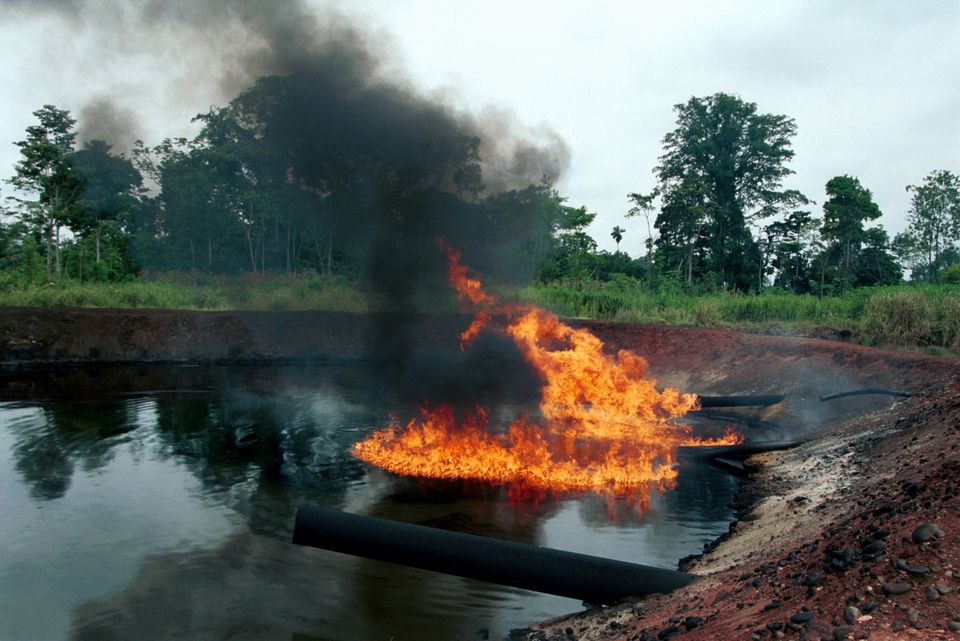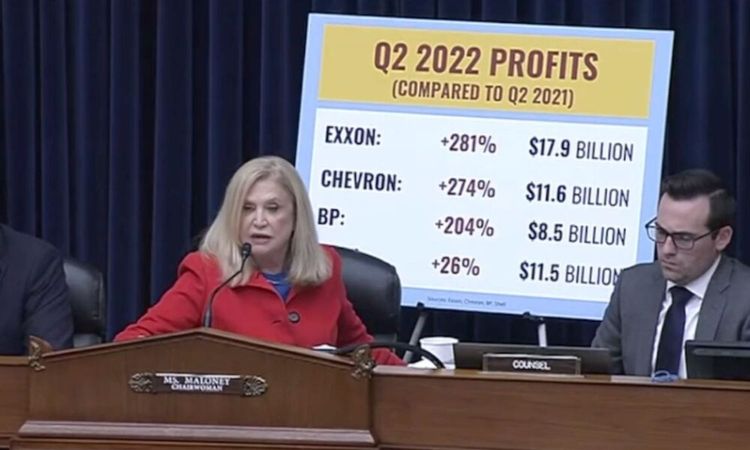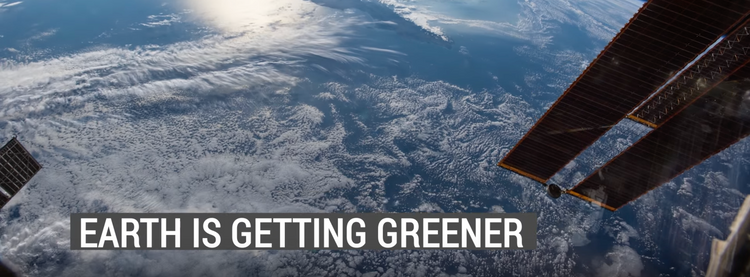Drilled Down: “Like a War on the Environment” —Texaco’s 30 Years in Ecuador

By Karen Savage
There is one core allegation at the center of the decades-long court fight by Indigenous Ecuadorians for environmental justice: That to save money, Texaco (later acquired by Chevron) deliberately dumped more than 18 billion gallons of toxic waste into hundreds of uncovered, unlined pits that now dot over a million acres.
Texaco has admitted to dumping 15.8 billion gallons.
Better technology might have prevented some of the subsequent environmental contamination from those pits, but Texaco chose not to use it.
Oil in its natural state is trapped underground and surrounded by water. During extraction, the water — referred to as production, waste, or formation water — rises to the surface with the oil. This waste water is salty and often mixed with oil, naturally occurring radioactive material, and other chemicals. It’s highly toxic, and must be handled and disposed of with caution.
In the U.S., stretching back decades to the 1970s, regulators require that drilling waste water be re-injected into the ground, where it is less likely to harm people or the environment. Texacos’s 1960s-era drilling predates that requirement, but at a minimum, as Tim Lagonegro, a geologist who spent more than 30 years consulting for oil companies, put it: “They had tarps back then, too.”
But in Ecuador, where there were no regulators making similar demands, Texaco saved billions by dumping its oily waste into unlined pits and leaving it there. The company dug these pits wherever it was most convenient. Sometimes those sites were next to homes, adjacent to drinking water wells, and uphill from rivers and streams local residents relied on for bathing and fishing.
Judith Kimerling, a former New York assistant attorney general who helped prosecute Occidental in the 1970s for its contamination of Love Canal, says what happened in Ecuador is appalling.
“I thought that we had learned in this country, from Love Canal, that you can’t just dig a hole in the ground, dump your toxic waste and walk away,” Kimerling says. “But that is exactly what Texaco, a U.S. company, was doing in the Amazon rainforest, in Ecuador. I went there in 1989 and they were still doing it then.”
With no lining in the pits, toxic waste seeped out easily into surrounding soil and water. Tropical rains, a near-daily occurrence in the warm humid region, mixed with the oily waste, causing the pits to overflow and further spread the toxic mix. Pipes drained oily water from the pits into nearby rivers and streams.
“I bathed how many times in those rivers full of oil, salted by the formation water?” says Donald Moncayo, an activist who was born about 200 meters from Texaco’s second well in Lago Agrio in 1973.
“We are still suffering from those damages, living in the uncertainty that at some point we are going to contract a catastrophic disease such as cancer,” says Moncayo, who still lives in the area.
Texaco also spread oil production waste over miles of local dirt roadways, where it stained children’s feet and ran off into ditches during heavy rains, spreading the contamination further.
“Texaco didn’t pave its roads and so it used waste, untreated waste oil, for maintenance and dust control,” Kimerling says. “The company deliberately dumped tons of toxic drilling and maintenance waste into the environment without treatment or monitoring.”
Moncayo was about nine years old when a Texaco tanker truck spreading oil on a road near Lago Agrio slid off of the slick surface and into a ditch. Workers called in a crane to try and pull the truck back onto the road.
Since “they couldn’t get it out because it was too heavy with the oil it held,” Moncayo says. Texaco’s solution was to drain the tanker’s oil into the ditch, which terminated at the estuary of the Aguarico, a primary waterway used for drinking water throughout this part of the Ecuadorian Amazon.
“They never cleaned that, it is intentional damage,” Moncayo says “That oil is there, in that place, and now they say they did not do it.”
Luis Yanza, an activist who has been working with the Ecuadorian plaintiffs for decades, moved with his family to Lago Agrio when he was six years old, and didn’t understand what this pollution was at the time, only that the ground smelled bad and stuck to his feet. Yanza would later represent a class of tens of thousands of plaintiffs from the area in a lawsuit against Texaco (commonly referred to as the Aguinda suit, after the lead plaintiff, an indigenous woman, Maria Aguinda).
“When I arrived in Lago Agrio in August 1977, when I got off the bus at dawn, the first thing I stepped on the ground was a viscous black oil,” Yanza said.
He also remembered the strange black clouds he could see on the horizon from his house.
“In each Texaco oil well, they used to build two or three pits or pools to deposit toxic waste and when those pools were filled, instead of treating those wastes, they were set on fire and that caused huge fires,” Yanza said. “That smoke was contaminating the atmosphere and that is why we saw in the distance those black clouds and they were the product of those fires, the toxic waste, the oil and the pools.”
For decades, Texaco, and then Chevron have blamed PetroEcuador, the state-owned Ecuadorian oil company, for the pollution that remains in the Ecuadorian rainforest. They claim that Texaco cleaned up its fair share—37.5 percent, commensurate with its profit share in the oil drilling consortium. But the plaintiffs argue that Texaco was the operator, overseeing everything and training Ecuadorian workers who were completely new to the industry, and teaching PetroEcuador how to drill. If PetroEcuador staff attended the “‘school’ of Texaco,” as Kimerling describes it, it was a failing school.
She recounts a 1991 visit to PetroEcuador’s facilities by U.S. Ambassador to Ecuador Richard Bloomfield summarized in a cable to President George H.W. Bush and Secretary of State James Baker. The ambassador sharply criticized PetroEcuador, with the following caveat:
“By most accounts, PetroEcuador’s treatment of the environment is the worst of all the oil companies in Ecuador. In part this is because it inherited from Texaco established fields where the existing equipment and procedures do not reflect current industry practices.”
Decades of Dumping
Texaco extracted oil from beneath Ecuador’s rainforest for decades. By the time the firm pulled up stakes in 1992, it had extracted at least 1.5 billion barrels of oil for the consortium, translating to profits estimated at more than $20 billion.
Left behind were the pits: murky cesspools of sludge that oozed out of the earthen walls into groundwater and soil. Plaintiffs contend they contained 16 billion gallons of oily waste, more than than the total spewed in the two worst oil disasters in U.S. history combined: the grounding of the Exxon Valdez in Alaska’s Prince William Sound in 1989, and the 2010 explosion and sinking of BP’s Deepwater Horizon drilling platform in the Gulf of Mexico.
The Lago Agrio plaintiffs estimate Texaco saved approximately $3 per barrel, and earned an additional $4.5 billion in profits, by not injecting the waste into the ground.
Petroleum geologist Timothy Lagonegro worked for 36 years in the oil and gas industry. He estimates that he lived or worked in about 70 different countries over those years, including two in Ecuador. Nowhere did he see abuses of industry norms more flagrant than Texaco’s actions in the Ecuadorian Amazon.
“It was almost like a war on the environment,” Lagonegro says.
“You would never put waste water in an unlined pit, never,” Lagonegro says. “Everyone knows that’s toxic water. Putting that into a rainforest? That’s an outlandishly bold-faced, schoolboy 101 drilling error. Extremely wrong, extremely dangerous.”
Indigenous residents say the contamination decimated the natural environment that had sustained them and their ancestors for thousands of years. Crops no longer yielded harvests. Once-ample fish stocks vanished, and the rainforest’s lush foliage began to die off.
But Chevron, which acquired Texaco’s potential liabilities when it bought the firm in 2001, says the damage claims against it are “false and unsupported by scientific evidence.” Chevron contends that any remaining contamination in the area is the responsibility of PetroEcuador, which it claims took over operations in 1990.
Although Texaco had pulled out of the Ecuador oil concession entirely by 1992, it retained easy access to the highest levels of the country’s government.
Dr. Rodrigo Perez-Pallares, a Texaco attorney, attended a meeting of oil companies in the country in the fall of 1994, along with Ecuador’s then-President Sixto Duran Ballen and several of his top officials.
By then, the Lago Agrio plaintiffs (a class of 30,000 indigenous people and campesinos who collectively refer to themselves as los afectados, or “the affected”) had sued Texaco in New York, and their accounts of babies born with horrific deformities, family members succumbing to cancer, and lack of clean drinking water generated an outcry around the globe.
In a report to D. York LeCorgne, then Texaco’s vice president for exploration and production for its Latin America-West Africa division in Coral Gables, Fla., Perez relayed that banks had begun to question Ecuador’s ability to protect its environment, and were “conditioning their loans to sound and firm environmental policies.”
President Duran “receives every day several letters from ecological organizations from all over the world, asking him to cancel (sic) all contracts with foreign oil and mining companies, which he will obviously never do,” Perez wrote.
He said attendees expressed “deep concern” with what was happening to Texaco and lamented the difficulty of working with indigenous and other social groups.
That December, Texaco entered into an agreement with the Ecuadorian government that would become central to the oil company’s defense of its practices in the country.
“The party sat down and worked out a remediation program where Texaco would address its proportionate share of the consortium, 37.5 percent,” Chevron spokesperson Kent Robertson told NPR’s Michael Martin in 2008, leaving PetroEcuador responsible for the remainder of the pollution.
Lagonegro says that Chevron’s contention that Texaco was responsible only for a portion of the cleanup proportional to its share in the consortium’s profits goes against the industry norm.
“Generally, the national oil company is really just looking over the shoulder of this really big, powerful multinational oil major,” Lagonegro says. “They really don’t get their hands on the operation. I think that’s an outlandish deception there, really and truly, and I don’t believe that for a second.”
Kimerling points out that a government official who Perez referred to in his report, Deputy Secretary for the Environment Giovanni Rosania,was also a consortium employee at the time.
“Rosańıa was employed by Petroecuador, on loan to [Ecuador’s Ministry of Energy and Mines] to head the agency’s environmental unit. Despite this apparent conflict of interest, Rosańıa played a central role as a public official in both environmental negotiations and implementation of the accord, including oversight and approval activities, during his tenure as Deputy Secretary,” Kimerling wrote in the journal International Law and Politics in 2013, adding that another signatory for the government was a former Texaco employee.
Rosańıa later testified in the Ecuadorian trial of the case against ChevronTexaco that he spoke about the agreement in several public meetings, assuring Indigenous groups and other organizations that the remediation agreement would not affect their right to hold Texaco (later Chevron) accountable. Similarly, Perez-Pallares testified that Ecuadorians retained the right to hold Texaco accountable.
Local residents said the remediation agreement underestimated the extent of the contamination, and that Texaco’s resulting efforts were insufficient at best, and in some cases made matters worse.
“A number of witnesses and reports say that at many locations, contaminated liquids were dumped into rivers and streams without proper sampling and treatment,” Kimerling wrote.
“Waste pits containing high levels of petroleum were backfilled without removing or treating the oil; crude oil that was removed from waste pits, and contaminated soils and vegetation, were buried in unlined holes in the ground and dumped in the environment, including at locations in nearby forests; crude oil and contaminated vegetation were burned in open fires; toxic chemicals were thrown into waters, killing fish; workers were badly treated; workplace safety norms were violated; and equipment and resources were reduced to save money,” Kimerling wrote, adding that governmental monitors were often kept in the dark about the extent of the work.
When workers protested the unsafe conditions, foremen threatened to replace them with Indigenous workers, according to Yanza. Indigenous men were already working clean-up under horrific conditions.
“It was terrible to see that the garbage was burned next to the pool itself in some small holes, but what moved me the most was seeing the workers buried in the oil almost up to the waist,” a leader of the Amazon Defense Front told Yanza. These workers told me that they did not have enough water because they were limited to a few glasses during the day. In these physical working conditions, and more climate in the region, the scene was truly one of slavery.”
Texaco’s remediation work has been the subject of investor-state arbitration, which we’ll delve into further later in this series. But testing of the remediated areas later found hydrocarbon levels in the area’s drinking water to be significantly higher than those acceptable under U.S. regulations.. Health studies showed shockingly high rates of cancer, miscarriage andother diseases associated with oil contamination.
“There is an urgent need to establish an adequate environmental control and remediation program in order to prevent unnecessary and unacceptable health hazards for these populations,” researchers who studied women’s health in the area concluded in 2001.
Decades later, little has changed for the area’s residents. They still suffer from high rates of respiratory illnesses, diabetes, and other oil-related health conditions, which lately have made them particularly vulnerable to the Covid-19 pandemic.
It’s heartbreaking that the news reports are now mostly about Steven Donziger, the American attorney who led the legal team that sued Chevron in Ecuadorian court, “and not about what’s happening in Ecuador,” Kimerling says.
Moncayo, who has worked with the plaintiffs and taken journalists and celebrities on “toxic tours” of the waste pits, says Texaco’s clean-up was like “cat remediation.”
“When the cat relieves itself, then it buries its manure,” Moncayo says “Here they dumped their filth and then they came with dirt and covered it.”





